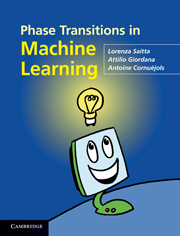Book contents
- Frontmatter
- Contents
- Preface
- Acknowledgments
- Notation
- 1 Introduction
- 2 Statistical physics and phase transitions
- 3 The satisfiability problem
- 4 Constraint satisfaction problems
- 5 Machine learning
- 6 Searching the hypothesis space
- 7 Statistical physics and machine learning
- 8 Learning, SAT, and CSP
- 9 Phase transition in FOL covering test
- 10 Phase transitions and relational learning
- 11 Phase transitions in grammatical inference
- 12 Phase transitions in complex systems
- 13 Phase transitions in natural systems
- 14 Discussion and open issues
- Appendix A Phase transitions detected in two real cases
- Appendix B An intriguing idea
- References
- Index
13 - Phase transitions in natural systems
Published online by Cambridge University Press: 05 August 2012
- Frontmatter
- Contents
- Preface
- Acknowledgments
- Notation
- 1 Introduction
- 2 Statistical physics and phase transitions
- 3 The satisfiability problem
- 4 Constraint satisfaction problems
- 5 Machine learning
- 6 Searching the hypothesis space
- 7 Statistical physics and machine learning
- 8 Learning, SAT, and CSP
- 9 Phase transition in FOL covering test
- 10 Phase transitions and relational learning
- 11 Phase transitions in grammatical inference
- 12 Phase transitions in complex systems
- 13 Phase transitions in natural systems
- 14 Discussion and open issues
- Appendix A Phase transitions detected in two real cases
- Appendix B An intriguing idea
- References
- Index
Summary
Ensemble phenomena such as the emergence of a phase transition are by no means limited to artificial and inanimate entities. On the contrary, in living beings one may not infrequently observe similar phenomena, whose origin can be tracked down to the effect of the interaction among many components. Indeed, in living organisms the number of cells cooperating in biological and physiological processes is so large that ensemble behaviors are only to be expected. The rapid transition between two neural states was observed as early as the late 1980s (Freeman, 1988). The experimental setting used by Freeman and co-workers included animal and human subjects, engaged in goal-directed behavior, on which high-density electrode arrays were fixed. Action potentials and brain waves (electroencephalograms (EEG) and local field potentials) were then recorded and used to develop a data-driven brain theory.
Freeman and co-workers designed data processing algorithms that enhance the spatial and temporal resolution of the textures of brain activity patterns found in three-layer paleocortex and six-layer neocortex. A major discovery of their work was evidence that cortical self-organized criticality creates a pseudoequilibrium in brain dynamics that allows cortical mesoscopic state transitions to be modeled analogously to phase transitions in near-equilibrium physical systems.
- Type
- Chapter
- Information
- Phase Transitions in Machine Learning , pp. 313 - 318Publisher: Cambridge University PressPrint publication year: 2011



